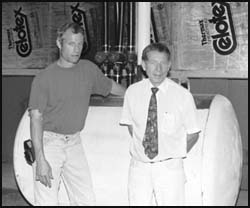 Instead of loading animal manure and hauling it to a field, a Freeport farmer has researched ways to turn animal manure into efficient energy.
Instead of loading animal manure and hauling it to a field, a Freeport farmer has researched ways to turn animal manure into efficient energy.Alvin Schlangen, Freeport, and Al Rutan, Liberty Center, Iowa, have been working together more than four years to devise a way to process animal manure so as to remove the odor and contamination and do it in a manner that is energy efficient.
Schlangen has installed a methane digester in a former chicken barn, which produces methane gas and aged, processed fertilizer from his 75,000 bird egg layer operation.
According to Rutan, all the previous attempts at employing the process of anaerobic fermentation, which is commonly used in most sewage plants, to a farm application have failed.
ďThis failure is not due to the fact the process doesnít work but rather the problem of energy balance. Until now all the on-farm applications have required more energy to keep them at the optimum operating temperature of 95 degrees fahrenheit than the process was able to produce. This has been due to the inability of most designers to effectively address the problem of a heat sink,Ē Rutan added.
In July, the two men focused on the digester and getting it operational. ďThe digester is similar to the human digestive tract,Ē Rutan said. ďEven heat is needed to process the product.Ē
Rutan said there is a parallel between this problem and the one the Wright brothers faced in successfully building a flying machine. Everyone knew that flying was possible because birds did it all the time. But all the attempts to imitate flight before the Wright brothers crashed. It was the Wright brothers who had the ďwrightĒ stuff, understanding better than others the laws of aero-dynamics.
A parallel between flight and producing biogas is based on the fact that methane gas is produced everywhere in natureóswamps, land fills, coal mines, etc. However, most people have been unsuccess at grasping the laws of thermodynamics in order to make the anaerobic process efficient in an on-farm application in a cold climate.
Rutan has spent more than 30 years working in the field of anaerobic fermentation to solve the problems of energy efficiency as it applies to farm animals and the handling of their manure in a northern climate. In his early experimental stages, Rutan used slurry from city sewage plants at Monticello, Hastings and St. Cloud.
The purpose of the Schlangen project is twofold: first, capturing and utilizing the energy of biogas in an efficient manner; and, secondly, processing the nonvolatile solids in the tank so that the end result is a product which is an aged, highly nutritious fertilizer free of odor, disease germs, weed seeds, and is not a threat to groundwater.
In their proejct, the manure which was previously a major problem from the danger of contamination to air and pollution to water becomes a product which is highly desirable, Rutan said.
The digester (an old petroleum tank) holds 9,200 gallons of manure. However, they do not fill the tank, leaving room for the methane gas to form at the top. The tank was enclosed in early August in a eight-foot wide and 44-foot long box which has warm water circulating throughout the lower half.
ďIt was a trial and error process to get the box so it was leak proof,Ē Schlangen said. Schlangen uses a water heater to regulate the heat in the box. He built a heat exchanger to save the exhaust heat from the water heater. The water outside the tank temperature ranges from 110 to 117 degrees fahrenheit at all times. The temperatures inside the tank average 98 degrees.
A 300-gallon milk bulk tank is being utilized as the scrubber for the methane gas. It contains lime water (calcium carbonate), which works to remove carbon dioxide. It also removes part of the hydrogen sulfide (odor) from the gas. Schlangen says the hydrogen sulfide needs to be removed before it can run an engine without corrosion. The hydrogen sulfide does not need to be removed to run a gas stove, however.
When the digester is operating at full capacity, it will utilize about a ton of manure per day. It takes 40 days for the manure to migrate from the front of the tank to the back.
Schlangenís laying hens produce about seven tons of manure per day. Of that total, one ton goes into the digester daily. The digester processes 2,000 pounds of manure daily. About 500 pounds is utilitized to produce methane gas while the remainding slurry goes to the other end of the barn where it will be dried for fertilizer. ďOnce the moisture is removed from the manure, it can be kept indefinitely,Ē Rutan said.
ďA short-term solution to the excess manure is that the manure will be spread traditional into the fields. As a long-term solution, weíll expand the operation to handle more,Ē Rutan added. ďOur first goal is to maintain the system. Secondly, our goal will be to market the energy product.Ē
Schlangen and Rutan will be holding a seminar at the Schlangen farm explaining and demonstrating their project on Monday, Sept. 28. For more information or to preregister, call 612-870-7461 or e-mail Schlangen at spi@.netmeans